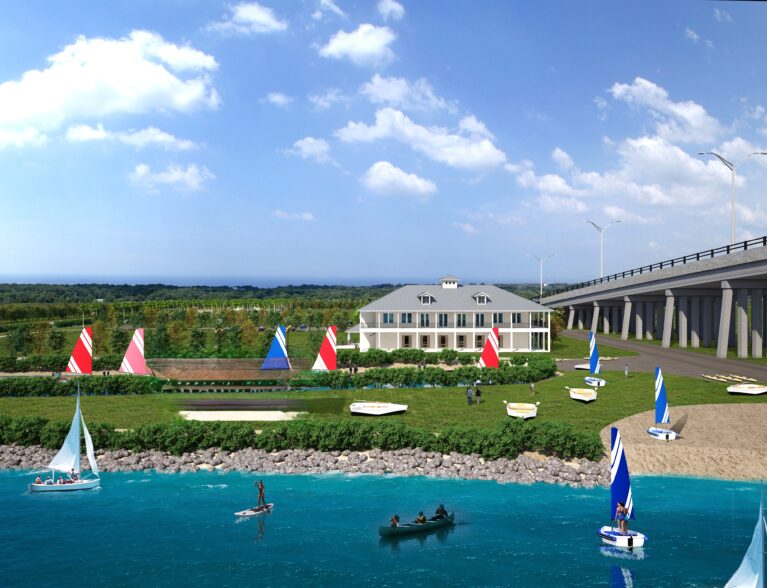
While selection of an overall developer for Vero’s planned Three Corners riverfront complex is still months away, the first element of the grand masterplan – the Youth Sailing Foundation’s new community sailing center at the western base of the Alma Lee Loy Bridge – is getting close to groundbreaking.
The Foundation submitted its site plan to the City of Vero Beach in early December and expects to get a response from city planners any day now.
In mid-December, the group signed a $4.5-million contract with Proctor Construction to build the Pat Harris Community Sailing Center, with groundbreaking scheduled for May.
“Proctor did a great deal of pro bono preconstruction work for us, and they are ready to go for the county permit,” said Stu Keiller, who served from 2016 until 2023 as executive director of the Foundation and now is project manager for the new building.
Proctor is a blue-chip construction company that built the Vero Beach Rowing Center in 2019, and Keiller says the new sailing center will be “a 100-year building.”
The two-story, 10,000-square-foot tropical colonial structure will be built on a forest of pilings that go down 20 or 25 feet to hard substrate, supporting a heavy concrete slab foundation.
“This is all fill land,” Keiller says of the building site adjacent to the city sewer plant, which is slated to be decommissioned in the near future. “The pilings go down through the mud layer to coquina.”
The first floor will be built of reinforced concrete block, and the second of hollow dense foam blocks that will be laced with rebar and filled with concrete to make a wall structure that is both stronger and lighter than traditional block. These will provide the added benefit of thermal and acoustical insulation.
“The second floor is the part that will be air conditioned, so the insulation is important,” says Keiller. “It will also dampen traffic noise from the bridge.”
The finish roofing will be standing seam aluminum, which resists corrosion better than a typical steel standing seam roof.
“It will also be a 100-year building because we are creating a maintenance fund, which will be in the $300,000 to $500,000 range,” Keiller says. “That is not for operating maintenance but rather a reserve fund for major repairs or needed renovation, such as a new roof.”
The building’s first floor will include expansive, well-equipped boat repair shops, boat storage space, onshore instructional space, a large office for the sailing program and restrooms with showers.
The second floor, which will have a cathedral ceiling, includes a conference room, a large assembly hall, three offices and two more large, multi-person restrooms.
There will also be an 11-foot-deep veranda along the front of the building facing the Indian River lagoon that will widen at the south end into a 900-square-foot terrace with sweeping views to the east and south.
“We have surveyed many sailing centers in Florida and the Northeast, and they all say the most used part of their centers are outdoor spaces, especially if they are elevated and have views,” says Keiller. The veranda and terrace will be equipped with high-end teak furniture selected by a local interior designer who supports the sailing organization.
Impressive as the new building appears on paper, Keiller says the project is not really about the building.
“It is the programs we will operate out of it that are the heart what we are doing,” he says.
Those programs include two 14-week terms during the school year in which about 150 children come to the current facility at the base of the bridge twice a week to learn sailing – along with self-confidence, resilience and problem solving. There is also a busy summer camp attended by 200-plus kids and a growing adult sailing program.
Keiller says Youth Sailing serves about 300 unique sailors each year, with considerable overlap between programs. That is up from 150 sailors a year five years ago. During the same period, the organization’s revenue has doubled from about $450,000 to $900,000, with 85 percent of the money coming from donations.
The young sailors mirror the county’s demographic, with solid contingents from 32963, Gifford and other areas. Sailors come from about 35 schools, including many church schools. Students at Vero Beach High School who participate can letter in sailing.
There’s also a program dedicated to special needs children who are provided with custom-designed boats from Australia and accompanied by volunteers. This program typically serves around 30 children each term.
About 50 percent of the kids come from what Youth Sailing calls “underserved” families, including a as many as 30 children from homeless families.
The children compete in three levels of regattas, from what Keiller calls “minor league” regattas held by half a dozen clubs between West Palm and Melbourne up to the U.S. Sailing Youth Championships held in far flung waterfronts on the Great Lakes, Gulf of Mexico, and East and West Coasts of the United States.
“Our kids sometimes dominate in the local regattas, taking first place in all three youth classes,” Keiller says proudly.
In a video available on the Youth Sailing website, numerous parents say that learning to sail and spending time out on the water capturing the wind has dramatically improved their children’s lives and mental outlooks, opening hopeful new horizons.
In fact, it is the appeal of these inspiring programs that made the new building possible.
Hundreds of people have donated to the capital campaign for the building but the largest “naming gift” of $1 million came from a person with no prior connection to Youth Sailing.
Pharmaceutical executive Jody Miller is a seasonal resident who likes boats and being on the water, owning a restored classic sailboat on the Great Lakes and a Grady White in Florida, but he did not know about Youth Sailing until someone at Vero Marine on Royal Palm Pointe mentioned it to him.
Shortly afterward, Keiller showed Miller around the existing facility and told him about the programs for underserved kids and special needs children.
“I took him to lunch after the tour and he said, ‘I’m going to give you $100,000’ for operations,” Keiller says. “A couple of years later when we launched the capital campaign, he told me ‘I’m going to give you a million dollars.’”
Instead of naming the new sailing center after himself or his family, Miller named it in honor of longtime Youth Sailing Foundation chairman Pat Harris, who died shortly after the $1-million gift was announced.
Another donor with no connection to Youth Sailing who liked the idea of children learning to sail sent a check for $675,000 completely out of the blue.
The happiness and success of young Vero sailors also inspires some 50 dedicated volunteers, who assist a dozen or so full- and part-time employees, teaching kids to sail and taking care of the organization’s fleet of 80 sailboats and 10 powerboats.
Youth Sailing has raised $5.1 million so far in its ongoing capital campaign, which will pay for the new building, equipment and the maintenance fund.
The area around the building will be transformed into the Charlie and Chris Pope Marine Recreational Park, with new roads, parking areas and other facilities, which will be open to the public to launch small boats and enjoy the riverside environment and sailing center.
Charlie Pope founded the Youth Sailing Foundation in 2009 with the help of his wife, Chris Pope, and led the organization until 2016. Both remain on the board, Christine as a director and Charles as Chairman Emeritus, according to the Foundation website.
Youth Sailing Foundation signed a 25-year lease with the City for the property in August that is renewable for another 25 years if the Foundation is in compliance with the terms of the lease.
“As long as we don’t turn it into a casino or something, it is basically a 50-year lease,” Keiller says.
The sailing center and park were designed in consultation with the city, county and Andres Duany, the architect and urban planner who created the masterplan for the Three Corners riverfront redevelopment project that was approved by 79 percent of Vero Beach voters two years ago.
The Pat Harris Community Sailing Center, which is slated for completion in 2026, will be the first piece of the masterplan to emerge from two-dimensional drawings to three-dimensional reality on the shore of the Lagoon.



